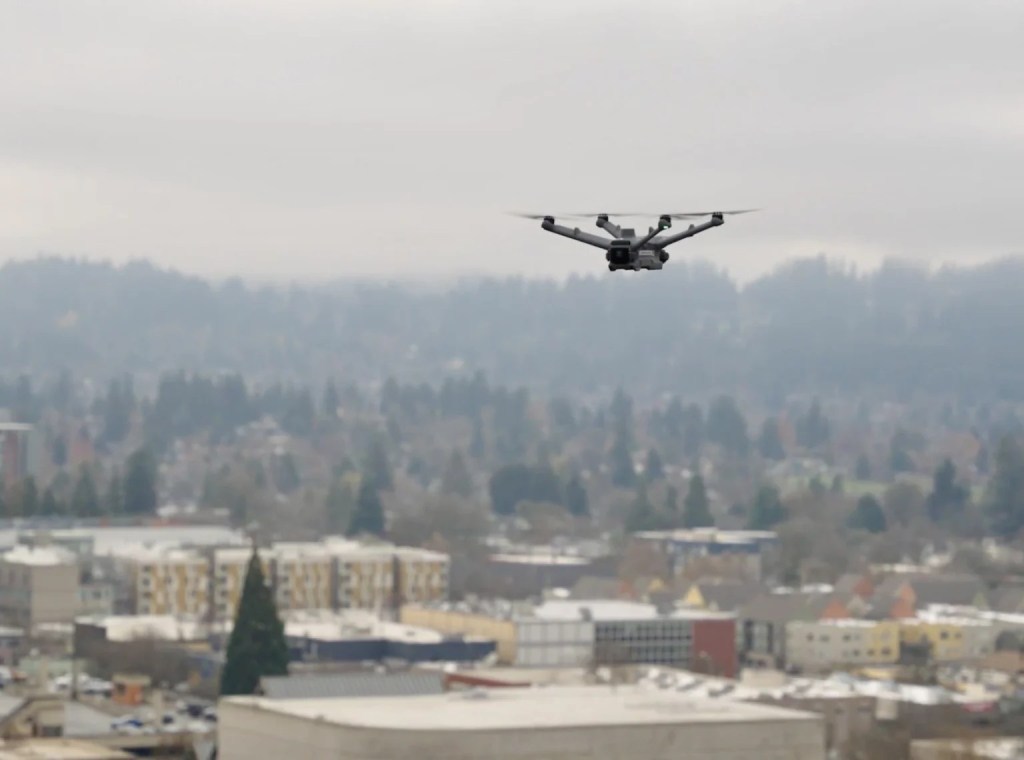Oregon police erred in use of aerial surveillance camera for marijuana bust, appeals court says
Published 6:22 am Thursday, July 3, 2025

- A drone flies above Eugene. Oregon’s Court of Appeals chided the Oregon State Police Wednesday for using warrantless, “technologically-enhanced surveillance” to bust an illegal marijuana operation. (Photo courtesy of Eugene Police Department)
The ruling was lauded by civil rights advocates and privacy watchdogs fresh off of a fight in the Oregon Legislature over a bill that would have granted more power to police to use unmanned aerial surveillance devices like drones
Oregon’s Court of Appeals chided the state’s police force on Wednesday for using warrantless “technologically-enhanced surveillance” to bust an illegal marijuana operation, sending the court’s clearest message yet about how law enforcement may use the increasingly popular, but controversial technology.
The case, captured in an eight-page ruling from a three-judge panel, centers on a June 2021 multi-county investigation involving the Polk County Sheriff’s Office and Oregon State Police. The defendant, 54-year-old Sengdara Nakhiengchahn, was not the target of the investigation, but Oregon State Police Sergeant Tyler Bechtel, a leading officer on the case, noticed “what looked to be a massive agricultural operation” that “was likely a marijuana grow,” while flying in a surveillance plane nearly 5,000 feet in the air, according to the ruling.
Trending
The defendant was charged in August 2021 with two felonies for possession and manufacturing of marijuana. She pled guilty in a conditional deal that allowed her to get the possession charge dropped by serving two years of probation, court records show. But she maintained her right to appeal the charges, arguing the evidence gathered from aerial surveillance constitutes a warrantless and unlawful search and should not have been admissible.
The appeals court agreed with Nakhiengchahn, returning the case back to the trial court where she can withdraw her guilty plea. Bechtel did not respond to an email seeking comment.
“While the trial court didn’t agree with us, we’re grateful the appellate court did,” said Luke Miller, Nakhiengchahn’s trial attorney, in a statement. “It’s important for Oregonians to maintain the right to privacy, and be free from government intrusion absent legal justification for such intrusion.”
Jenny Hansson, a spokeswoman for the Oregon Department of Justice, said officials were still reviewing the decision and could decide to appeal the court’s ruling in the coming weeks.
Jolene Kelly, a spokeswoman for the Oregon State Police, declined to comment on the ruling or its findings, but said in an email the agency “remains committed to following applicable laws and court directives.”
The ruling was lauded by civil rights advocates and privacy watchdogs who were fresh off of a fight in the Oregon Legislature over Senate Bill 238, which would have extended unprecedented power to police to use unmanned aerial surveillance devices like drones when responding to 911 calls, executing a warrant, or responding to “exigent circumstances.” The bill ultimately died in the House Rules Committee without a vote.
Trending
The ACLU of Oregon opposed the bill, warning in a news release that it was unnecessary and “undermines basic rights including privacy and free speech.”
Kelly Simon, legal director of the ACLU of Oregon, said Wednesday’s ruling marks an “important decision to ensure that as police technology advances, we are maintaining the integrity of our warrant requirements under the Oregon Constitution.”
“We’re beginning to see in the surveillance tech industry all sorts of high-powered enhancements,” she told the Capital Chronicle. “It is important that our courts maintain the integrity of our warrant requirements by making sure that if law enforcement wants to use those enhancements, they go to court first, they present the evidence they have against a person, and they get permission to do that.”
In the ruling, Justice Scott A. Shorr wrote that state police saw “materially different information” through a camera attached to their aircraft than what could’ve been seen with a naked eye, striking down a decision by Polk County Circuit Judge Rafael A. Caso to allow evidence tied to the camera footage to be admitted at trial.
“We have never upheld as constitutionally permissible an officer’s technologically enhanced surveillance to see what was otherwise indiscernible. We decline to do so here,” Shorr said. “In this case, the officer used technology to obtain information from inside defendant’s private structures that was undetectable from his vantage point in public airspace.”
Technology intended for ‘search and rescue’
Oregon courts have held that officers can use aerial surveillance in illicit marijuana cases, but only if officers can identify plants without aids that enhance vision beyond what the naked eye can see. That has allowed them to perform inspections of different marijuana farms and suspected facilities from heights as low as 500 feet, using tools like night vision scopes to increase lighting.
The recorded footage of the defendant’s house that was captured by Sgt. Bechtel was handed to the local Polk County sheriff, who worked with a neighbor of the defendant to take photos of her house, including evidence of cannabis plants. Officers then observed marijuana greenhouses from a road nearby the house. That evidence, along with the aerial images, allowed them to get a search warrant.
The Court of Appeals on Wednesday did not go so far as to outright ban the technology in question, noting their decision was “narrow and confined to the circumstances of this case.” But the court signaled that officials must be ready to have separate evidence to back up their assertions if they do use enhanced aerial surveillance from devices like helicopters, jets or drones as evidence for a warrant or arrest.
“This opinion does not preclude the ability of police to use technology, under certain circumstances, to aid in their aerial observations,” the opinion reads. “We have repeatedly upheld the police use of technology to record what was openly visible to the observing officers.”
The camera Bechtel used was a Wescam MX-10, manufactured by one of the largest defense contractors in the United States — Florida-based L3Harris Technologies. A spokesperson for the group said “we do not have a comment to offer” in an email.
The device still appears to be in favor with Oregon lawmakers, who recently approved $1.2 million for State Police to purchase another Wescam MX-10 camera during the latest legislative session. Though it’s been billed as a way “to assist the department with a camera with thermal capabilities,” the camera has also been advertised by military equipment sellers on helicopters and small planes for “low-altitude” and “tactical surveillance” scenarios.
“The camera would provide rapid identification of lost or missing persons during search and rescue operations or natural disasters and enable pilots to find hidden and dangerous suspects during critical incidents,” reads a recent Oregon State Police budget proposal. “The Wescam MX-10 would also significantly enhance communication with the ability to stream live video and communicate directly with [Oregon State Police] command for critical incidents and natural disasters.”
Kelly of the Oregon State Police did not respond to a question about how many of these similar cameras the agency has used in the past few years.
The use of such technology without warrant alarmed a leader of another major national privacy advocacy group, who criticized law enforcement that “conduct warrantless searches and erode our privacy.”
“The Court of Appeals reached the right decision here,” said Jeramie D. Scott, senior counsel and director for the D.C.-based Electronic Privacy Information Center’s Project on Surveillance Oversight, in a statement. “Hopefully in the future, Oregon State Police will seek a warrant first to conduct this type of aerial surveillance, so a neutral arbiter can decide whether the search is warranted.”








